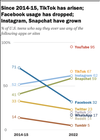Study confirms the obvious: youth have abandoned Facebook
Teen usage of the social media platform has more than halved in less than a decade.

Facebook’s declining popularity among younger demographics is widely known by now, but a recent study just revealed how far the once all-encompassing social media platform has fallen from grace in teens’ eyes. According to the Pew Research Center’s new “Teens, Social Media and Technology” report surveying internet users aged 13-17, only about 32-percent of responders say they ever use Facebook. That’s a well over 50-percent decline from 2014-15’s estimated 71-percent usage.
Meanwhile, TikTok is remains the current social media platform to beat for Gen Z, with 67-percent of responders claiming to frequently visit the app. Two other social media platforms—Instagram and Snapchat—also saw sizable increases over the past eight years. Another result gleaned from the study shows that YouTube is by far the website teens utilize most, with 95-percent of those surveyed saying they frequent the platform.
[Related: Facebook will try to make its news feed more personal again.]
Check out Pew Research’s infographic below for a wider view of the current social media landscape (RIP, Vine).

The demographics among teenagers on social media has also shifted significantly, according to the report. “For example, teen boys are more likely than teen girls to say they use YouTube, Twitch and Reddit, whereas teen girls are more likely than teen boys to use TikTok, Instagram and Snapchat,” reads the study. “In addition, higher shares of Black and Hispanic teens report using TikTok, Instagram, Twitter and WhatsApp compared with White teens.”
Unsurprisingly, all this social media usage has generated some undesirable byproducts. For example, of the 95-percent of teens visiting YouTube, one-in-five of them say they use it “almost constantly,” while a little over half of survey takers say they’d have difficulty giving up their favorite social media haunts for good. Perhaps this shouldn’t come as too much of a surprise— access to smartphones skyrocketed for the age group since Pew last surveyed the landscape—from 72- to 95-percent of teens.
